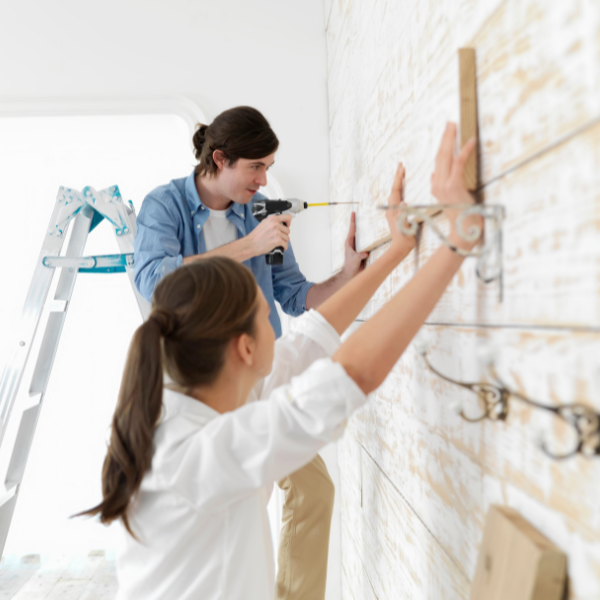
Specific home improvements pay off if you put your house on the market, and some of these do not cost much money. Also, many people can make these simple but worthwhile improvements themselves or get the help of a family member, friend, or neighbor to do the work for a reasonable cost.
On the other hand, more extensive home renovations, like fully remodeling a kitchen or adding an extra bedroom and bath, cost a substantial sum and usually involve hiring professionals and getting building permits. Additionally, if you are selling a house, the increase in sales price for large renovations often does not offset the investment. Big-ticket exceptions that do often recoup the cost include replacing the roof, exterior painting, and installing a new garage door.
Nonetheless, there is a lot you can do for minimal cost and effort to make your house stand out to prospective buyers and help you get the best price, including these ideas:
1. Deep Cleaning:
When you start by deep cleaning a home, repairs and maintenance that need attention become much more apparent. Also, it is easier to sell a house if the owner removes most or all of their possessions. Deep cleaning a home is a perfect time to organize, donate, and dump household stuff. A clean and decluttered home lets potential buyers see and appreciate the space and more easily imagine making it their own.
-
Deep cleaning involves:
2. Interior Painting:
Once you remove curtains and clutter, the need for fresh paint might become more apparent. A coat of interior paint can do wonders for the appearance of a home. The keys to success are good preparation before painting and using high-quality paint. High-quality paints are more expensive, but they can save the time needed for a second or third coat, making them a more efficient option.
-
White or near-white paint is best in most situations, or choose a neutral tone like light grey or light blue if you want to add color. Preparing for painting involves:
Painting is easier if you use a brush or roller designed for your painting surface.
3. Replacing Kitchen and Bathroom Cabinet Hardware:
Installing new hinges, knobs, and drawer pulls on kitchen cabinets and applying a coat of paint on the front sides while the hardware is off can make a kitchen sparkle. Installing new hardware also provides an opportunity to fix doors and drawers that don’t close properly. Often, non-closing doors are due to a build-up of paint on the back edge of the cabinet doors, broken or bent hinges, or misaligned latches or drawer slides.
When you remove the doors to install new hinges, it’s easy to scrape down the back edge of the door with a plane or sander so the door completely closes when reinstalled. If hinge screws have worked loose, patch the holes and sand when dry. Then, drill pilot holes for screws and reinstall the hardware. Remove drawers and reattach or replace slide hardware.
4. Tidying Up the Landscape:
Besides hauling away debris, raking leaves, and mowing the lawn, a few strategically placed new plants in the ground or attractive containers can make your home’s yard look relaxing and inviting. Potted plants near entranceways are especially effective for adding color and vibrancy around the house.
In addition, trim out dead branches in trees and shrubs and fix holes or broken rails in fences. Make sure gates open and close easily and latch securely. Mow, then water and fertilize the lawn to green it up in the weeks before you put the house on the market.
5. Fixing Minor Repairs:
-
Unattended minor repairs can make an otherwise lovely house look shabby and put off prospective buyers. Repairs worth doing include:
6. Replacing Faucets:
Outdated kitchen and bathroom faucets are relatively easy to replace. When installing new fixtures, replacing the shut-off valves and hoses connecting the taps to the water source can prevent leaks when you turn the water on. New, brushed brass or nickel faucets stand out in a freshly painted bathroom or kitchen.
7. Upgrading Lighting Inside and Outside:
Track lights in the kitchen can be a significant improvement over a single overhead light fixture. Hanging pendant lights over vanities are also eye-catching and make a bathroom more functional and pleasant. Outdoors, consider installing solar-powered lighting along pathways and strings of decorative bulbs over decks and patio areas.
8. Staging the Home:
Staging is another task worth considering when you want your house to sell fast for the best price. Staging involves furnishing and decorating the home to appeal to most buyers. Also, a staged home is ready to show on short notice. Real estate specialists report staged homes often sells for approximately $40,000 over the asking price. You can hire a pro to do the staging or do it yourself, and you can live in the house while it is staged.
These home projects are low-cost and straightforward, and unlike additions and remodeling, you don’t need a building permit for these upgrades. In addition, many homeowners can do the work themselves or with the help of family, friends, and neighbors. These tasks can make your home sell faster for a higher price with minimal investment.

